|

                   
Caribbean foto phantasy...
|
|
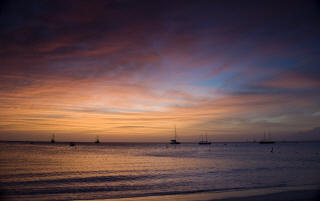
Angry red sunset: 18mm, .6ND grad filter |
Back in 2008, I picked up a new hobby - photography.
Since then, I've been reading, talking to experts and
practicing. In conjunction with a business trip to
Chicago and Pittsburgh, I decided to burn some frequent
flyer miles and hotel points to take a five day "sanity
vacation" to Aruba. I'd been to
Aruba in 2004 and done
all the sightseeing I cared to do, so on this trip I
instead set out on a right brain adventure to improve my
technique in photographic composition, using depth of
field and applying filters to control light. |
|
|
Saturday April 25th I arrived at 12:30pm AST and taxied over to the
Aruba Marriott on
Palm Beach. I had a nice northwest view room to begin my photo
adventures (first picture below: 170mm, f/8, 1/250s, ISO200).
I unpacked my photo gear which consisted of two cameras (Nikon
D300 and Canon SD870), three lenses (Nikkor 18-200mm, Nikkor
35mm f1.8, Sigma 10-20mm), two filters (Hoya HD digital
circular polarizer and Tiffen graduated .6 neutral density),
an underwater enclosure for the Canon, a Vanguard Tourist 5
tripod and a Think Tank Speed Demon camera fanny pack to carry
it all around. Whew!
|
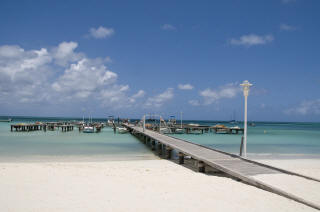
Sittin on the dock of the bay: 18mm, cir polar filter |

Room with a view |

Calm waters at dusk |

Morning beach light |

Afternoon "On Desire" |
|
Walking south about a mile along the
beach I found a good wine shop that provided basic snack and
soft drink supplies as well as guidance on a couple of
outstanding South American reds. I grabbed dinner at the new
Hard Rock Cafe
nearby and then took another beach walk at dusk. The
sunset was calm, cloudless and clear (second
picture above: 95mm, f/7.1, 1/200s, ISO200, .6 ND grad filter).
I used the graduated neutral density filter to bring up the
light of the foreground ocean. I applied the
"rule of thirds" in composing this and many other shots on
this page. I can't imagine why this simple composition
principle isn't printed on the first page of every point and
shoot camera users manual.
Sunday
April 26th
I started the day with an ocean swim and then quickly returned to snap the
vivid morning light on Palm Beach in the third shot above
(18mm, f/11, 1/500s, ISO200). I did another long walk south on
an inland pathway practicing the use of a circular polarizing
filter to bring out or suppress reflections. I stopped for a
Sunday afternoon tapas brunch at
Chino Latino before heading
back. I shot the large picture at the top of the page right -
"Sitiin on the dock of the bay" as the afternoon sun began to
fade using the circular polarizing filter to cut out
reflections on the water. I spent some time on my balcony
reading my first book of the trip, "On Desire - Why we want
what we want" by William Irvine (highly recommended). The fourth picture above was
taken from the tripod at 18mm, f/22, 1/250s, ISO200.
|
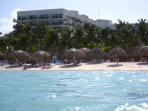
Ocean lookin back |
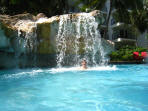
Pool cues |
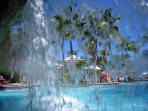
Behind the waterfall |
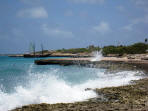
North coast splash |
|
Monday
April 27th
I hit the beach early armed with snorkel gear and my Canon
SD870 in its underwater enclosure. The water wasn't clear
enough for good underwater pictures, but the perspective from the
water was interesting (first picture
above). I took a lot of shots in the ocean before heading to
the pool. The second and third pictures above were taken using
manual settings on the Canon SD870 to hike up the vibrance by
one tick. After a quick lunch on my balcony, I headed north
for a long walk along the rugged shoreline north of Palm Beach
(fourth picture above taken with the Canon) to the California
Lighthouse. Monday's sunset gave me another opportunity to use
the neutral density graduated filter. By playing with the
exposure and aperture a bit, I shot the first picture below
(200mm, f/9, 1/320s, ISO200) highlighting some solar flares. I
later brought out an eerie blue
in the ocean foreground in Photoshop by adjusting the color
temperature. In the
second picture below, taken a few minutes later, I kept the
high telephoto setting and increased the aperture farther to
collapse the near and far fields (200mm, f/7.1, 1/200s,
ISO200).
Tuesday
April 28th
I did my longest hike of the trip on Tuesday, roughly 10 miles
south to Eagle Beach and back. Eagle Beach is at the
"low-rise" hotel area of Aruba's west coast. I found it to be less
crowded, but with fewer photo opportunities. The third picture
below (36mm, f/13, 1/640s, ISO200) is of one of many windswept Divi trees that pop up all over the beach there.
After a late lunch at Palm Beach's iconic
Salt & Pepper, I walked back to the hotel and relaxed
until just before sunset. Tuesday's sunset was the best of the
trip, lighting up first in brilliant blues and then turning to
an angry red. The fourth picture below was shot as the sky
turned colors casting an interesting tone on the boat tied to
its dock (18mm, f/3.5, 1/60s, ISO200, .6 ND grad filter). The
large picture, top of page left, "Angry red sunset", was shot
from the beach after the sun was down and the sky was red. My
last shot, "Blues and reds sailing on the horizon" below was
taken without the filter from the sand level looking up, then
cropped vertically to the panorama.
|
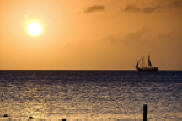
Solar flares over deep blue |
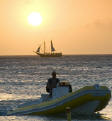
Near/far, new/old |
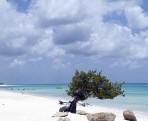
Eagle Beach Divi |

Pullin ropes |
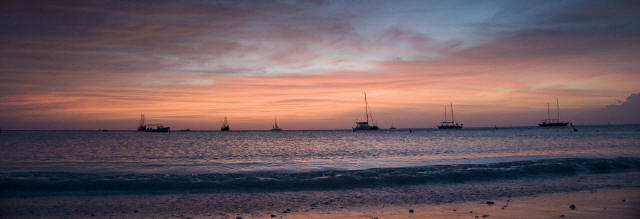
Blues and reds sailing on the horizon: 18mm, f/3.5, 1/80s,
ISO200 |
|
Wednesday
April 29th
Wednesday was my last morning in Aruba before heading home. I
spent the time swimming and relaxing. In closing,
I thought I'd share some of what I learned photographically.
The first two pictures below illustrate the difference that
proper depth of field makes. The first picture highlights the
subject well with a low depth of field while the second
picture shows the clutter that happens with a normal depth of
field. Both shots were taken with my 35mm f/1.8 primary lens
in aperture priority mode, dialing in the f stop. The third
and fourth pictures below show the effect of a circular
polarizing filter. While it's not clear which shot is better,
it is clear that they are very different shots. Finally, using
the .6 neutral density graduated filter was tricky, but
allowed for much better foreground lighting in sunset shots.
|

Low depth of field: f/1.8 |

High depth of field: f/22 |

Circular polarizer filter |

Unpolarized |

                   
Mackey Group, Inc.
© 2002 - 2021
|
|